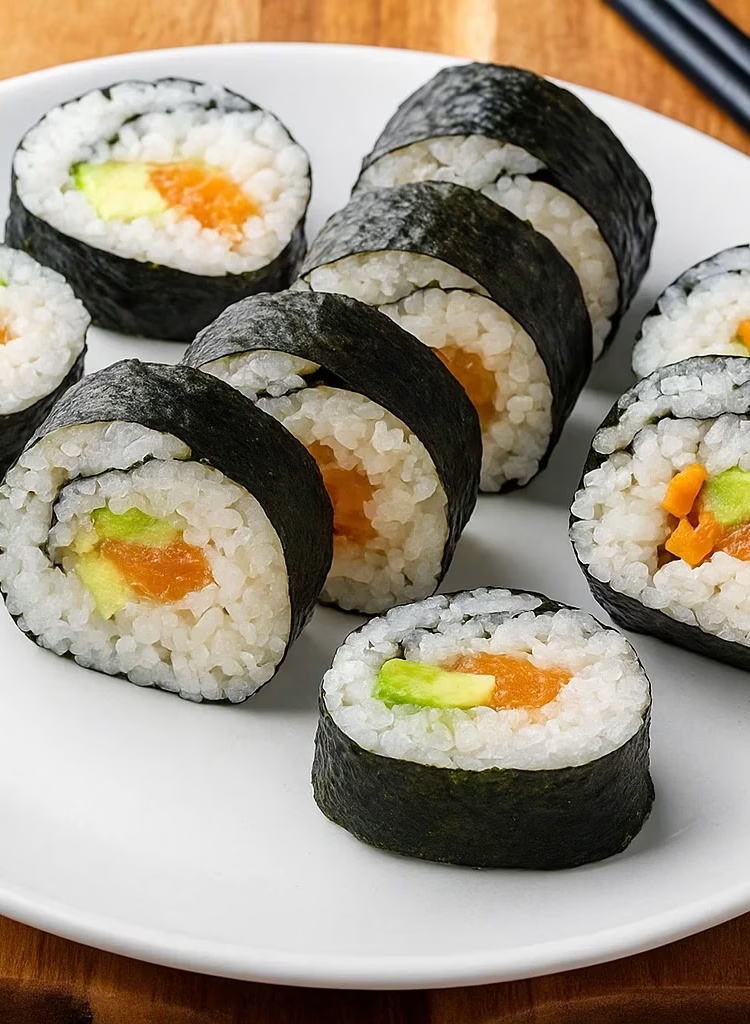Homemade Sushi Recipe - A Complete Guide
Prep time: 45mins | 4 Servings (24 Pieces)

If you’ve ever dreamed of recreating the delicious sushi rolls from your favorite Japanese restaurant, you’re in the right place. Making sushi at home is not only fun and rewarding, but it also allows you to customize flavors, control ingredients, and even save money. This homemade sushi recipe guide will walk you through everything you need to know from essential tools to step-by-step instructions so you can roll sushi like a pro in your own kitchen.
Salisbury Steak Recipe – A Cozy Classic You’ll Want on Repeat
Why Make Sushi at Home?
Before we dive into the recipe, let’s explore why making homemade sushi is such a great idea:
Cost-Effective: A restaurant sushi platter can cost a fortune. At home, you can prepare multiple rolls for the same price.
Customizable: Whether you love vegetarian sushi, spicy tuna, or California rolls, you control the ingredients.
Healthier Choice: You can use fresh fish, whole grain rice, and even lower-sodium soy sauce for a healthier twist.
Fun Activity: Rolling sushi is creative and interactive, perfect for family dinners, date nights, or hosting friends.
Essential Tools
Before you start, make sure you have the right equipment:
- Bamboo sushi mat (makisu) for rolling
- Sharp knife for clean cuts
- Rice paddle or wooden spoon for mixing sushi rice
- Cutting board
- Plastic wrap (optional, to cover the bamboo mat)
Ingredients
Here’s what you’ll need to make classic sushi rolls (makes 4–5 rolls):
For Sushi Rice:
2 cups short-grain sushi rice
2 ½ cups water
⅓ cup rice vinegar
2 tbsp sugar
1 tsp salt
For the Rolls:
5 sheets of nori (seaweed)
Fresh fillings (choose any):
Raw fish like salmon or tuna (sushi-grade)
Cooked shrimp or crab sticks
Avocado, cucumber, or carrots
Cream cheese for fusion rolls
Soy sauce, pickled ginger, and wasabi (for serving)
Directions
1. Prepare the Sushi Rice
Rinse the rice under cold water until the water runs clear.
Cook the rice in a rice cooker or on the stove.
While it cooks, mix rice vinegar, sugar, and salt in a bowl until dissolved.
Once the rice is done, gently fold in the vinegar mixture with a wooden spoon. Let it cool to room temperature.
2. Get Your Fillings Ready
Slice fish and vegetables into thin strips.
Keep all ingredients fresh and ready for easy rolling.
3. Assemble the Sushi Roll
Place a nori sheet on the bamboo mat, shiny side down.
Spread a thin, even layer of sushi rice over the nori, leaving a 1-inch border at the top.
Add your chosen fillings horizontally across the center.
Using the bamboo mat, carefully roll the sushi away from you, pressing gently to keep the roll tight.
Seal the edge with a little water.
4. Slice and Serve
Dip your sharp knife in water before cutting to prevent sticking.
Cut each roll into 6–8 even pieces.
Serve with soy sauce, wasabi, and pickled ginger.

Popular Homemade Sushi Variations
Experiment with these crowd-pleasing rolls:
California Roll: Crab stick, avocado, cucumber, and sesame seeds.
Spicy Tuna Roll: Tuna mixed with sriracha and mayo, cucumber, and scallions.
Vegetable Roll: Carrots, cucumber, avocado, and bell peppers.
Philadelphia Roll: Smoked salmon, cream cheese, and cucumber.
Tips for Perfecting Your Homemade Sushi Recipe
Use sushi-grade fish for safety and freshness.
Don’t overfill the rolls; too many ingredients make rolling harder.
Keep a bowl of water nearby to dip your fingers and prevent rice from sticking.
Experiment with toppings like sesame seeds, spicy mayo, or tobiko (fish roe).
Nutrition Facts
*Per serving (1 sushi roll)
- Calories250 kcal
- Protein9 g
- Carbohydrates36 g
- Fat6 g
- Saturated Fat1 g
- Cholesterol20 mg
- Sodium340 mg
- Fiber3 g
- Sugar4 g
*Note: Nutrition may vary depending on ingredients and portion size.
FAQ's on Homemade Sushi
Q1. Can I make sushi without raw fish?
Yes! Try cooked shrimp, crab sticks, or go fully vegetarian with avocado, cucumber, and carrots.
Q2. What kind of rice should I use?
Short-grain sushi rice works best. It becomes sticky enough to hold the rolls together.
Q3. How do I store leftover sushi?
Homemade sushi is best eaten fresh. However, you can store it in the refrigerator, tightly wrapped, for up to 24 hours.
Final Thoughts
Making sushi at home may seem intimidating, but once you try it, you’ll realize how simple and enjoyable it is. From preparing the rice to customizing fillings, this homemade sushi recipe is versatile, affordable, and perfect for beginners and sushi lovers alike.
So why not grab your bamboo mat, invite some friends over, and create your own sushi night?


Pingback: Vegetable Beef Soup - A Comforting Classic for Every Season